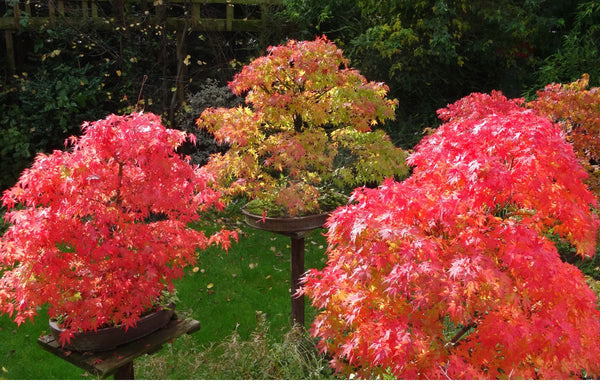
The Beauty of Japanese Maples
Japanese Maples, or Acer palmatum, have been cultivated for centuries in Japan, where their stunning autumn transformation—referred to as "Momiji"—is highly cherished. With their distinctive finger-like leaves and vibrant colors, these trees have become a beloved feature in gardens worldwide, adding sophistication and elegance to both public and private landscapes.

Japanese Maples in Europe
Japanese Maples were introduced to Europe through international plant trade in the 19th and 20th centuries, quickly becoming a favourite among gardeners due to their beauty and adaptability. While they do require some attention, they are relatively low-maintenance trees, making them a popular choice in many European climates. With proper care, they can thrive for decades, enhancing gardens across the continent.
Growing Japanese Maples in Pots
Despite being full-sized trees, Japanese Maples grow slowly, which makes them well-suited to growing in pots or even as bonsai. Their slow growth, combined with their striking appearance, has made them a popular choice for container gardening in European urban and suburban spaces.
When potting Japanese Maples, opt for a shallow but wide container to accommodate their shallow root system. A pot around 60cm in diameter, or with a volume of 50-75 litres, works well. Ensure that the pot has adequate drainage holes to prevent waterlogging, which can be harmful to these trees.
For younger trees, use a pot that’s just a little larger than the root ball to avoid pot shock, which can occur if there’s too much space between the roots and the pot walls.

Care Tips for Potted Japanese Maples
-
Sunlight and Placement: In most European climates, Japanese Maples prefer dappled or filtered sunlight. Position your tree in a spot sheltered from harsh afternoon sun and strong winds, which can damage the foliage and branches.
-
Temperature: These trees are well-suited to Europe’s temperate climate, thriving in temperatures between 13-24°C. While they are relatively hardy, it’s important to provide protection from both extreme summer heat and cold winter frost, particularly in northern Europe.
-
Soil: Japanese Maples thrive in well-draining soil that is slightly acidic to neutral. A well-aerated, loose soil mix is ideal for encouraging healthy root growth. Mulching around the base of the tree helps to maintain moisture and regulate temperature.
-
Watering: Water your potted Japanese Maple consistently but avoid over-watering. Ensure the soil stays evenly moist, particularly during dry spells. Check the top 5-10cm of soil and water when it feels dry. Wide, shallow pots tend to dry out faster, so be sure to monitor the moisture levels regularly.
-
Fertilisation: The best time to fertilise is in late winter or early spring, as the tree comes out of dormancy and begins its growing season. Use a slow-release fertiliser with a low nitrogen content to encourage steady, healthy growth.
-
Pruning: Regular pruning is essential for maintaining the tree's size and shape. Remove any dead or damaged branches and thin out areas where growth is too dense to allow sunlight and air to penetrate.
-
Repotting: As your Japanese Maple grows, you’ll need to repot it every 2-3 years. The best time for this is during the dormant period in late autumn or winter, reducing the stress on the tree. If you wish to keep it in the same pot, root pruning is necessary to prevent it from becoming root-bound.

Common Problems and Solutions for Potted Japanese Maples
-
Drying Out: Potted Japanese Maples are more susceptible to drying out, particularly during hot weather or in windy conditions. Consider using a self-watering pot or drip irrigation to maintain moisture levels, especially in southern European climates.
-
Root-Bound: As the tree grows, its roots may outgrow the pot, causing it to become root-bound. Signs of this include stunted growth, wilting, and poor leaf production. Repotting or root pruning will help alleviate this issue.
-
Pests and Diseases: Although fairly resistant, Japanese Maples can sometimes suffer from common garden pests like aphids or fungal issues such as powdery mildew. Regularly inspect your tree and use organic insecticides or fungicides as needed.
-
Fertilisation Issues: Be cautious not to over-fertilise, especially with nitrogen-rich products, which can cause weak, rapid growth. Japanese Maples grow best when allowed to develop slowly. Avoid fertilising in late summer or autumn to prevent frost-sensitive new growth.
-
Wind Damage: The broad canopy of Japanese Maples makes them vulnerable to wind damage when grown in pots. A wide pot offers greater stability, but it's still essential to place your tree in a sheltered spot to protect it from strong winds.
Japanese Maples are not just trees; they are living works of art that can be enjoyed by gardeners across Europe. Their seasonal changes, graceful appearance, and ability to thrive in pots make them a timeless addition to any garden, large or small.
Explore the beauty of Japanese Maples alongside Magnolia Trees: A Classic Choice. For a landscape that highlights their elegance, visit Garden Tour: Harrison’s Landscaping. Looking to brighten your outdoor space further? Read Transforming Your Winter Garden in Europe.
